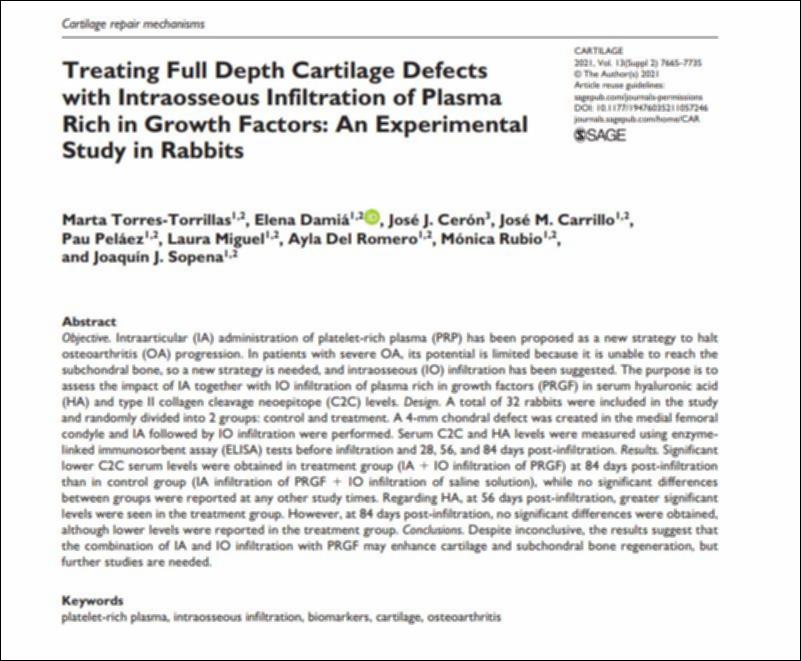Por favor, use este identificador para citar o enlazar este ítem:
http://hdl.handle.net/10637/15182Treating full depth cartilage defects with intraosseous infiltration of plasma rich in growth factors: an experimental study in rabbits

Ver/Abrir:
Treating_Torres_CARTILAGE_2021.JPG
111,69 kB
JPEG
Ver/Abrir:
Treating_Torres_CARTILAGE_2021.pdf
Acceso restringido
275,58 kB
Adobe PDF
Request a copy
| Título : | Treating full depth cartilage defects with intraosseous infiltration of plasma rich in growth factors: an experimental study in rabbits |
| Autor : | Torres Torrillas, Marta Damiá Giménez, Elena Cerón, José J. Carrillo Poveda, José María. Peláez Gorrea, Pau Miguel Pastor, Laura Romero Martínez, Ayla del Rubio Zaragoza, Mónica. Sopena Juncosa, Joaquín Jesús. |
| Materias: | Plasma sanguíneo; Blood plasma; Conejos; Rabbits; Osteoartritis; Osteoarthritis; Rodillas; Knee; Cartílagos; Cartilage; Factores de crecimiento; Growth factors |
| Editorial : | Sage |
| Citación : | Torres-Torrillas, M., Damiá, E., Cerón, J.J., Carrillo, J.M., Peláez, P., Miguel, L., Del Romero, A., Rubio, M. & Sopena, J. J. (2021). Treating full depth cartilage defects with intraosseous infiltration of plasma rich in growth factors: an experimental study in rabbits. Cartilage, vol. 13, i. 2_suppl (dec.), pp. 766S–773S. DOI: https://doi.org/10.1177/19476035211057246 |
| Resumen : | Objective: Intraarticular (IA) administration of platelet-rich plasma (PRP) has been proposed as a new strategy to halt osteoarthritis (OA) progression. In patients with severe OA, its potential is limited because it is unable to reach the subchondral bone, so a new strategy is needed, and intraosseous (IO) infiltration has been suggested. The purpose is to assess the impact of IA together with IO infiltration of plasma rich in growth factors (PRGF) in serum hyaluronic acid (HA) and type II collagen cleavage neoepitope (C2C) levels. Design: A total of 32 rabbits were included in the study and randomly divided into 2 groups: control and treatment. A 4-mm chondral defect was created in the medial femoral condyle and IA followed by IO infiltration were performed. Serum C2C and HA levels were measured using enzyme-linked immunosorbent assay (ELISA) tests before infiltration and 28, 56, and 84 days post-infiltration. Results: Significant lower C2C serum levels were obtained in treatment group (IA + IO infiltration of PRGF) at 84 days post-infiltration than in control group (IA infiltration of PRGF + IO infiltration of saline solution), while no significant differences between groups were reported at any other study times. Regarding HA, at 56 days post-infiltration, greater significant levels were seen in the treatment group. However, at 84 days post-infiltration, no significant differences were obtained, although lower levels were reported in the treatment group. Conclusions: Despite inconclusive, the results suggest that the combination of IA and IO infiltration with PRGF may enhance cartilage and subchondral bone regeneration, but further studies are needed. |
| Descripción : | Este recurso no está disponible en acceso abierto por política de la editorial. |
| URI : | http://hdl.handle.net/10637/15182 |
| Derechos: | http://creativecommons.org/licenses/by-nc-nd/4.0/deed.es |
| ISSN : | 1947-6035 1947-6043 (Electrónico) |
| Fecha de publicación : | dic-2021 |
| Centro : | Universidad Cardenal Herrera-CEU |
| Aparece en las colecciones: | Dpto. Medicina y Cirugía Animal |
Los ítems de DSpace están protegidos por copyright, con todos los derechos reservados, a menos que se indique lo contrario.

